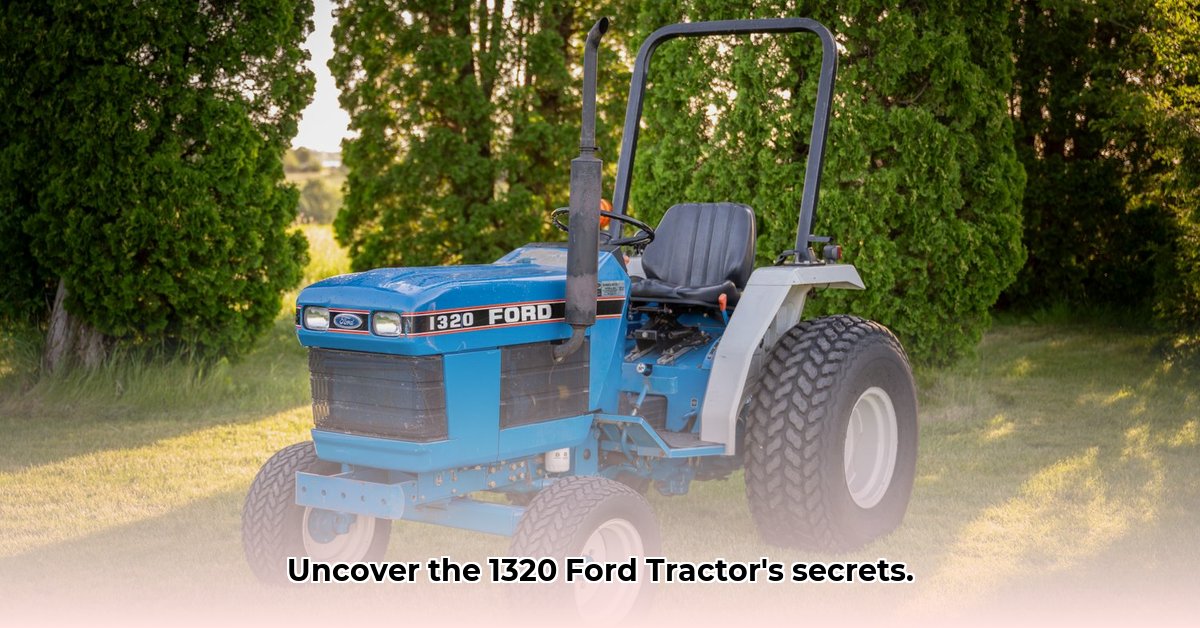
The Ford 1320 tractor, a compact workhorse produced from 1987 to 1995, holds a unique position in agricultural history. While not a powerhouse compared to modern machines, its manageable size and capabilities made it a popular choice for smaller farms and specialized tasks. This article delves into its technical specifications, historical context, maintenance considerations, and its enduring relevance today. For more information on similar Ford tractors, check out this useful resource.
Technical Specifications and Capabilities
The 1320, manufactured by Shibaura (a Japanese company), offered approximately 19 net horsepower (a standardized measure of engine power). This power output, coupled with its 6.9-gallon hydraulic system, provided ample capability for a variety of implements. The 540 RPM rear power take-off (PTO) – with an optional mid-PTO – further enhanced versatility, allowing for a wide range of attachments from mowers to snow blowers. However, its open-center hydraulic system, while standard for its time, was less efficient than the closed-center systems found in more modern designs. This difference in hydraulic design might translate to less responsiveness and energy efficiency when compared to newer tractors.
A detailed comparison with contemporary competitors (Kubota and Yanmar) is proving challenging due to limited readily available data from that era. This research is ongoing, and we are committed to providing a comprehensive comparison table in future updates. However, based on available information, we can assert that the target market for this compact tractor was owners needing a smaller footprint and lower overall cost than their larger counterparts.
Historical Context and Market Positioning
The Ford 1320 emerged during a period of shifting demands in the agricultural sector. Smaller farms and niche operations were looking for more maneuverable and versatile machines. Its approximate price of $12,200 in 1987 (adjusted for inflation), positioned it within a competitive landscape. Precise production numbers remain elusive, hindering a complete market analysis. Its Japanese manufacturing origin – from Shibaura – however, reflects the growing trend of globalized agricultural equipment manufacturing driven by cost optimization. What can we learn from the limited sales data currently available? It suggests consumer preference for value at the time.
Performance and Reliability: Assessing the Ford 1320
Assessing the performance and reliability of the Ford 1320 requires a nuanced approach. While anecdotal evidence suggests generally positive experiences from owners, quantifiable data is scarce. This scarcity highlights a challenge in researching older machinery; much of the detailed operational information is simply not readily available. However, the simple design of the 1320 – fewer complicated electronic components – likely contributed to its relative reliability.
Maintenance and Repair: Keeping Your Ford 1320 Running
Maintaining a Ford 1320 requires diligent attention to routine tasks. Regular oil changes, filter replacements, and careful monitoring of the hydraulic system are paramount. However, parts availability poses a significant challenge. The tractor's age and Ford's subsequent withdrawal from the compact tractor market creates difficulty sourcing replacement parts. Online forums dedicated to vintage tractors and specialized parts suppliers may offer solutions, but sourcing some components can require significant effort and even custom fabrication.
Modern Relevance and Value: Collectors, Farmers, and Beyond
The Ford 1320 retains value in different segments. For collectors, it represents a piece of agricultural history – a link to the past. Small-scale farmers may still find it useful for certain tasks, but a careful cost-benefit analysis is vital, weighing repair costs and parts availability against the investment in a modern machine. Given its age, operational life expectancy should be carefully considered when compared to potential replacements. Its enduring appeal is a testament to the quality of its construction and simple design.
Conclusion: The Enduring Legacy of a Compact Tractor
The Ford 1320, while no longer in production, remains a significant piece of agricultural history. Its compact size, reliable performance (in its time), and relative simplicity make it a compelling subject of study for collectors and enthusiasts. While challenges exist in parts sourcing and direct comparison to more modern equipment, the 1320's enduring legacy underscores the importance of understanding the evolution of agricultural technology. Further research into its production numbers and more in-depth comparative data with similar models from Kubota and Yanmar is ongoing.